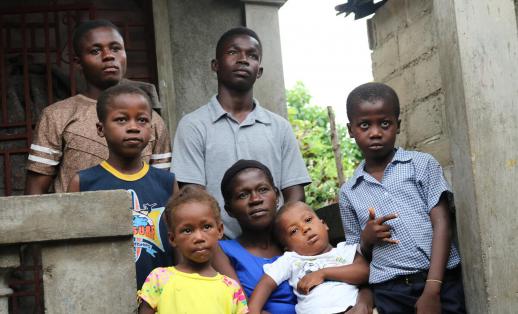At the UN Afghanistan pledging summit, world leaders must step up for girls’ education

Over six months on since the Taliban takeover, Afghan girls are still being denied their right to education.
Whilst the closure of girls’ secondary schools was introduced as a temporary measure, the de facto ban on girls’ secondary education has cost them over 200 million days of learning to date. [1]
Every day girls are out of school they are at increased risk of violence, abuse, and exploitation.
No one knows the impacts of school closures better than girls themselves – and those that teach them.
Afri*, 12-years-old from Faryab told us, “I am afraid of school closing news; I feel very worried and think of the bad situation I will be in for the future. If I was stopped going to school all my wishes will not come true. And then I will be a useless person my whole life, will not be able to change harmful traditions in my life and then in future I will not be able to help my children too.”
Afghan girls and women, together with their teachers and communities, continue to advocate for girls’ right to education in Afghanistan – even at great personal risk. And it seems like the de facto authorities are finally heeding their calls.
We share the profound disappointment and frustration of Afghan secondary school girls and women, who continue to be excluded from education, despite multiple assurances to the contrary by the de-facto authorities.
Afghan girls deserve more than empty words – this must now be put into action.
The international community must condemn this move that deprives girls of access to their basic rights and urge the de facto authorities to reverse this decision and allow all girls to safely return to school immediately. To make this a reality, governments and the authorities need to tackle both pre-existing and new barriers to ensuring safe, quality, inclusive secondary education for all.
The UN Afghanistan humanitarian pledging conference, co-hosted by the UK, Germany, and Qatar later this month, is a key opportunity for the international community to come together in support of girls’ education and raise the funds urgently needed to deliver the new education sector plan.
While the situation remains fluid, the education sector has developed a new plan – set out in the Afghanistan Education Sector Transitional Framework - to prevent the collapse of the education system, keep schools open and ensure all teachers and children continue in the teaching and learning process.
Risks to girls’ education
Even before the transition of power in August 2021, the education system was ranked amongst the top eight at most ‘extreme risk’ globally. Despite improvements in girls’ secondary school access,[3] over 2 million out of the 4 million out-of-school children were girls.[4]
Afghan children were still not learning, and girls in low-income, rural areas were least likely to complete school. Adolescent girls faced multiple barriers including harmful gender norms and attitudes, child marriage, violence, and insecurity.
Challenges with poor infrastructure, learning materials and a lack of qualified female and male teachers were exacerbated by the change in leadership and suspension of development funding.
The education system was highly dependent on aid, with development funding contributing to almost 50% of the national education budget.[5]
Following the transition of power, a further one million girls have been excluded from school, almost doubling the number of out-of-school girls at secondary level. Teacher salaries have not been paid for months,[6] leading to growing rates of teacher, and subsequently student, absenteeism and drop-out.[7] Shortages of qualified female teachers serve as a barrier to girls’ access to education, preventing girls from graduating and entering the teaching profession, and further perpetuating this cycle.
Following joint advocacy from Save the Children and our partners, the World Bank has approved the release of $1 billion in funds held within the Afghanistan Reconstruction Trust Fund (ARTF), starting with $600 million to support sectors including education.
To support the cash crisis and prevent a total collapse of the education system, a priority is ensuring $150 million in funding is distributed through UNICEF for teacher stipends.
Without additional support from the international community – both urgent humanitarian funding and long-term development assistance, Afghanistan’s education system will collapse. Schools will remain shut; teachers will continue to be unpaid and millions of children– especially girls – will be denied their right to quality education.
Afghan girls cannot wait
Later this month, the Governments of the UK and Germany will co-host the UN Humanitarian Pledging Summit to raise funds for Afghanistan’s Humanitarian Response Plan. The summit is a key opportunity to fully fund the Plan and secure additional support for the delivery of basic services, like education.
Of the US$4.4 billion required to fund the Plan, US$162 million is requested for education to reach 1.5 million children. This is a critical first step. However, millions more Afghan children, including girls, require further assistance to access quality education, as most of the Afghanistan’s education needs fall outside the Plan.
Moreover, unless concrete steps are taken to address the economic crisis in Afghanistan and reduce household poverty, no matter how effective the humanitarian response, households will struggle to send their children to school.
- Widespread hunger and non-payment of public sector workers is likely to lead to a steep fall in demand for girls’ schooling as more families fall below the poverty line.[9]
- Rates of early marriage and child labour are already rising as families’ coping and protection mechanisms are depleted.[8]
The international community must use the opportunity of the pledging summit to build support for renewed international assistance for education in Afghanistan, including by ensuring funding is available to implement the new Afghanistan Education Sector Transitional Framework.
They can do this through:
Fully funding the Transitional Framework worth $1.5 billion, which includes the $160 million to fund the education component of the Humanitarian Response Plan by making ambitious pledges. This funding can be channelled through existing mechanisms including the Education Cannot Wait Multi-Year Resilience Programme and the Global Partnership for Education, as well as NGO and civil society partners.
Ensuring that $150 million in funds held in the World Bank ARTF is distributed through the UNICEF mechanism to pay teacher stipends.
Ensuring funding is available for development and humanitarian actors to build the capacity and number of female teachers from primary through to university as a key solution to address lack of capacity.
Releasing earmarked funds available to humanitarian and development actors that will support girls’ education. This will be an important step to demonstrate willingness to engage and support Afghanistan, without imposing conditions, whilst continuing to underscore the importance of girls’ rights.
Coordinating with existing mechanisms to collect data to monitor and audit girls’ safe return to school at secondary level and hold the de facto authorities to account for their commitment.
We have a unique opportunity to come together behind a plan that will both build on, and protect, the gains in girls’ education access of the last twenty years. Afghan girls cannot wait; the girls’ secondary education crisis requires urgent action from the international community to deliver their right to – and demand for – safe, and quality education.
Press Release 23rd March 2021 - We are apalled by the decision to continue the ban on Afghan girls education by the Afghanistan authority: https://www.savethechildren.net/news/afghanistan-save-children-appalled-reports-formal-ban-girls-education-will-continue-secondary
[1] Malala Fund, Rights in Jeopardy: How the international community should respond to the girls’ education crisis in Afghanistan (2022) https://assets.ctfassets.net/0oan5gk9rgbh/7g4kBUGcwObBfXQQ7DSmNR/f4537ba205fb8cc7f6eb719cf5f09306/AfghanistanPolicyBrief_07_FullRes.pdf
[5] https://www.aljazeera.com/news/2022/2/21/unicef-stipend-afghanistan-teachers-emergency-support
[6] As noted in UNESCO’s rapid data collection through Provincial/District Literacy Managers (PLMs/DLMs), facilitators and beneficiaries from 34 provinces of Afghanistan.
[7] Human Rights Watch, 2021. Afghanistan Facing Famine. https://reliefweb.int/report/afghanistan/afghanistan-facing-famine
[8] https://reliefweb.int/sites/reliefweb.int/files/resources/A_76_667_E.pdf see also https://www.savethechildren.net/news/afghanistan-fifth-starving-families-sending-children-work-incomes-plummet-past-six-months







